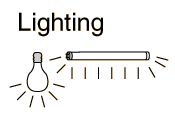Incandescent Lighting
 |
Although there are a large number of lighting options, the majority of lighting in homes is done by either incandescent or fluorescent lights. Fluorescent lighting has a considerable advantage in energy efficiency over incandescent lighting. Fluorescent lights can produce 50-100 lumens/watt compared to about 15 lumens/watt for incandescent bulbs. |
As an example, a 60 watt incandescent bulb produces light by heating a tungsten filament. A review by Denardo suggests that the temperature of the filament of a 60 W bulb is 2780 K. If you treat it as a blackbody radiator at that temperature and calculate the fraction of power in the visible wavelength range of 400-700nm, the result is 5.7% . That figure may be a bit low - typical figures quoted are 7%. Some factors affecting the real efficiency are the variation of the eye's sensitivity for the different wavelengths, and the possibility that some of the UV could be converted to visible in the material coating the bulb.
| Comment on energy cost | Energy units |
| Household energy use |
Practical electric circuits
Reference
Bloomfield
Ch 12
Denardo
| HyperPhysics***** Electricity and Magnetism | R Nave |